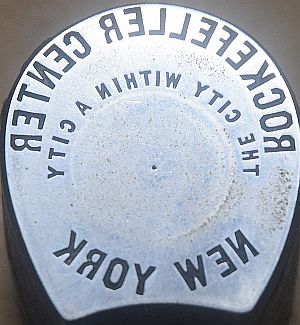
Encased Coin Dies
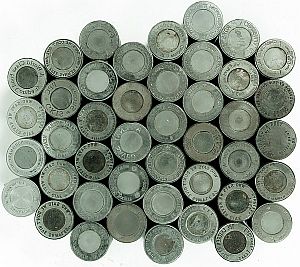
This is a "lot" of circular encased cent dies that recently sold at auction.
Encased cents are made by placing the coin (cent) on a coin press and pressing it between two dies. The dies are the "anvil die" and the "hammer die".
For making encased coins the "anvil" die needs to have the place for the coin to sit during the striking process as opposed to the minting of a new coin where the blank is fed into the press as the dies move. The coin is hand-fed into the press for an encased coin. This is done because the orientation of the coin relative to the legend is important. Further, the "heads" or obverse of the coin is usually matched up with a standard die and the reverse of the coin with the "message" or advertisement side of the encasement.
Below you see two "anvil" dies. Notice on the first that the die center is lower than the surface of the die. When striking the encased coin the coin is placed in the depression of the "anvil" die. Then the washer or ring is placed on the die and the "hammer" die strikes imprinting the "legend" and symbols on the washer and firmly encasing the coin in the aluminum encasement.
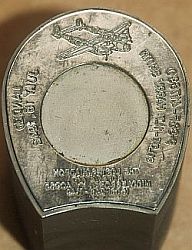
Horseshoe die P38 Bomber image - The die reads: P-38F-417630 / PILOT - 1 LT. HARRY SMITH / LANDED JULE 15, 1942 / THE LOST SQUADRON / P.O. BOX / 776/ MIDDLESBORO, KY 40985 / (608) -248 -1149 - The story of the "Lost Squadron" can be found HERE.
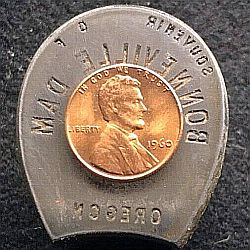
horseshoe-shaped die reads: "SOUVENIR OF / BONNEVILLE DAM / OREGON". A 1960 dated cent is laid in the center of the die to show scale.
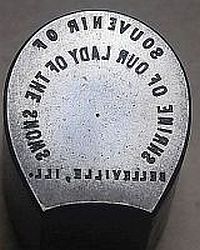
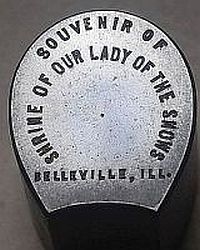
Encased coin "Hammer Die. The die reads: "SOUVENIR OF / SHRINE OF OUR LADY OF THE SNOWS / BELLEVILLE, ILL. - (Hover for flipped readable image)
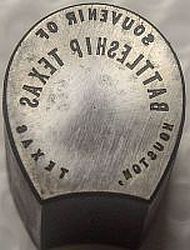

Encased "Hammer Die" The die reads: SOUVENIR OF / BATTLESHIP TEXAS / HOUSTON, TEXAS (Hover for flipped readable image)
Above you see two "hammer" dies. These dies struck the "anvil" die and encased the coin while adding the legend to both sides of the coin. In the early years of striking encased cents the die frequently overlapped the coin leaving an imprint of part of the design on the coins. Below you can see how the die left imprints on the coin. Note the areas of the cent by the clover leafs.

1901 Obverse Four Leaf Clover Left and Right Stem showing the imprint of the "hammer" die on the cent.
The imprinting of parts of the legend on the coin doesn't happen as often now as it did in 1901, but it is not unknown.
Depending on the customer a "stock" die may be used for either side of the encasement along with a custom die. Below are more custom dies.
The imprinting of the message and symbols on the aluminum, (usually), washer or ring also squeezes the aluminum to hold the coin in the encasement. If you examine an encased cent closely you will frequently be able to see slight deformation of the coin. It may be slightly concave or warped. This is caused by the pressure of the press. Sometimes it is very slight, and at other times pronounced. At this time the die may overlap the coin causing the coin to show imprints from the die.
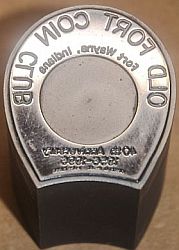
Encased coin die horseshoe-shaped. "OLD FORT COIN CLUB / Ft. Wayne, Indiana / 40th Anniversary / 1959-1996 -
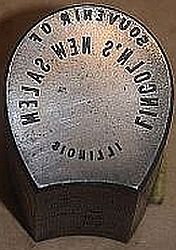
Encased coin die horseshoe-shaped. "SOUVENIR OF / LINCOLN'S NEW SALEM / ILLINOIS"
The above two dies are "anvil" dies. Note the area in the center to hold the coin in place during the encasing of the coin. These dies remained stationary and the "hammer" die then struck encasing the coin and creating the legend and symbols.
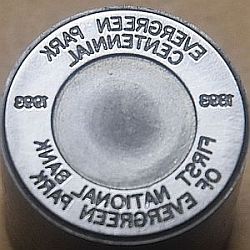
A circular anvil die "EVERGREEN PARK / CENTENNIAL /1938 / FIRST NATIONAL BANK / OF EVERGREEN PARK / 1938.
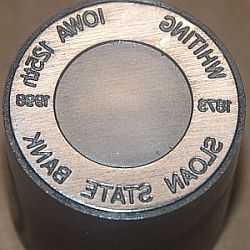
A circular anvil die - "WHITING IOWA 125TH / 1873 / 1998 / SLOAN STATE BANK"

A horseshoe-shaped hammer die for "ROCKEFELLER CENTER / THE CITY WITHIN A CITY / NEW YOUR - A nice souvenir from Rockefeller Center
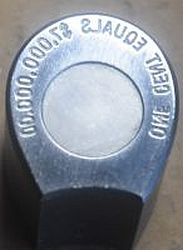
A horseshoe-shaped anvil die - The image shows the surface and one side of the die. "ONE CENT EQUALS $7,000,000.00". This one is a bit of a mystery. How does One Cent equal 7 million dollars??
Here are some other views of encased dies. This die is now owned by me and these photographs were taken by me.
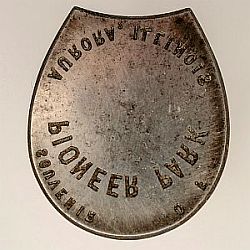
This is the surface of the die. This is a "Hammer" die. It reads: "SOUVENIR OF / PIONEER PARK AURORA, ILLINOIS
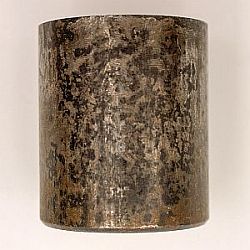
Side view of the Aurora die. This view is of the round top of the horseshoe encasement.
The two views of the die show the striking surface and the physical size of the die. It is approximately 1.37 inches/34.9 mm at the widest point and 1.59 inches / 40.5 mm in height. I used electronic digital calipers to determine this. The die weighs 12.5 ounces. At the bottom of the die see the image below. it has a threaded hole approximately .84 inches /21.5 mm in depth and .26 inches / 6.6 mm in diameter. Since this is the "hammer" die it has to be held firmly in place as it moves up and down when striking a coin/encasement. I wish I had a picture of a press used to make encased coins so I could post it here. Unfortunately, I know of no one who is currently making encased coins. If you have such a picture I would be interested in posting it here. I did an image search on "Google" and found several presses that could do the job. I chose not to copy their images as I am not sure that the machine would work and the image is the property of someone else.
Below are several other views of the "Aurora Pioneer Park" die.
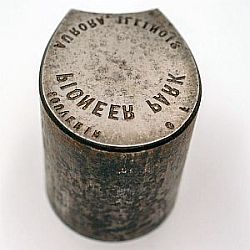
3-D view of a horseshoe-shaped encased coin hammer die showing the striking surface and side. It reads: "SOUVENIR OF / PIONEER PARK AURORA, ILLINOIS"
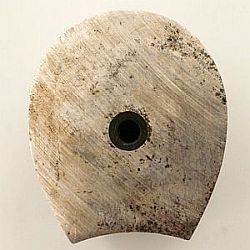
This is the bottom of a "hammer" die. Flat shaped like a horseshoe with a small .26 inches diameter threaded hole in the middle.
Home | Articles | Varieties | Coin Links | About | Terms of Use
Site Copyright 1999-2021 by Bruce Perdue Email: Webmaster All Rights Reserved ©Copyright Bruce Perdue


